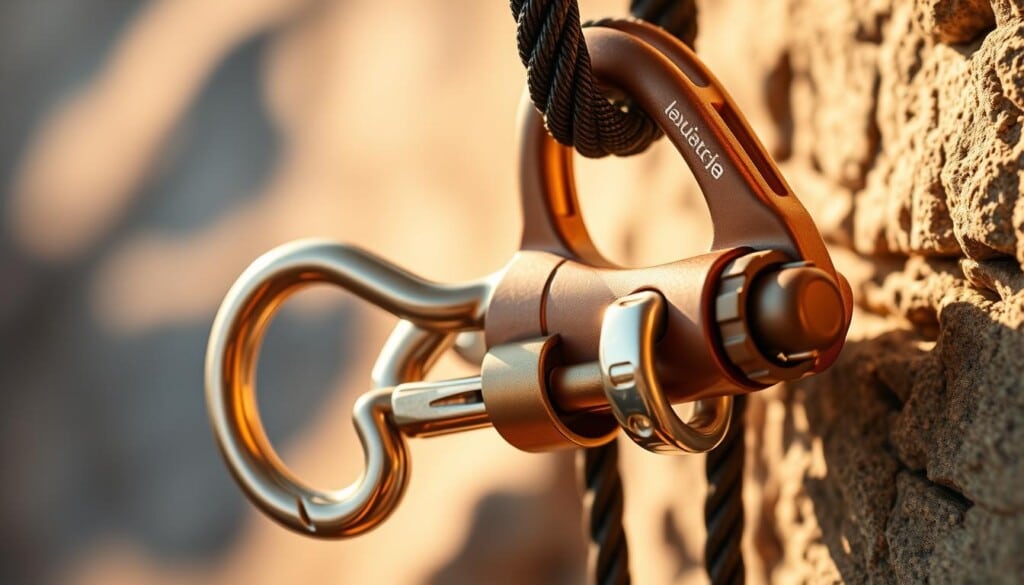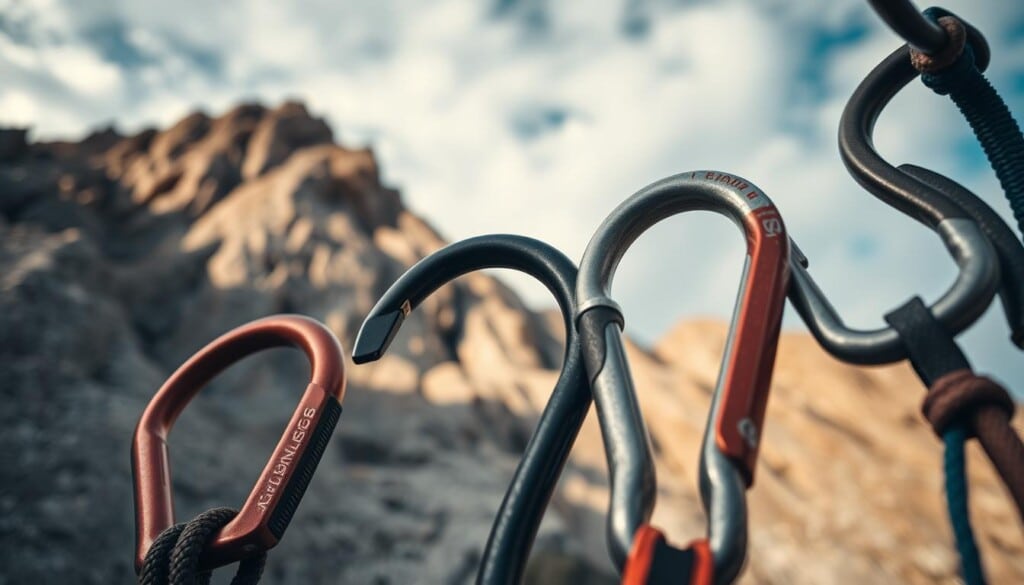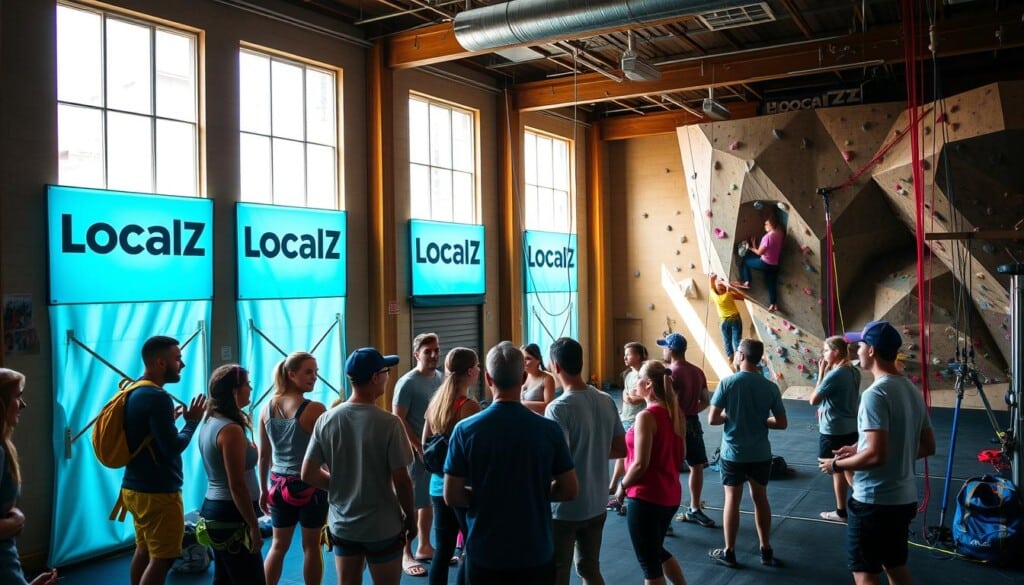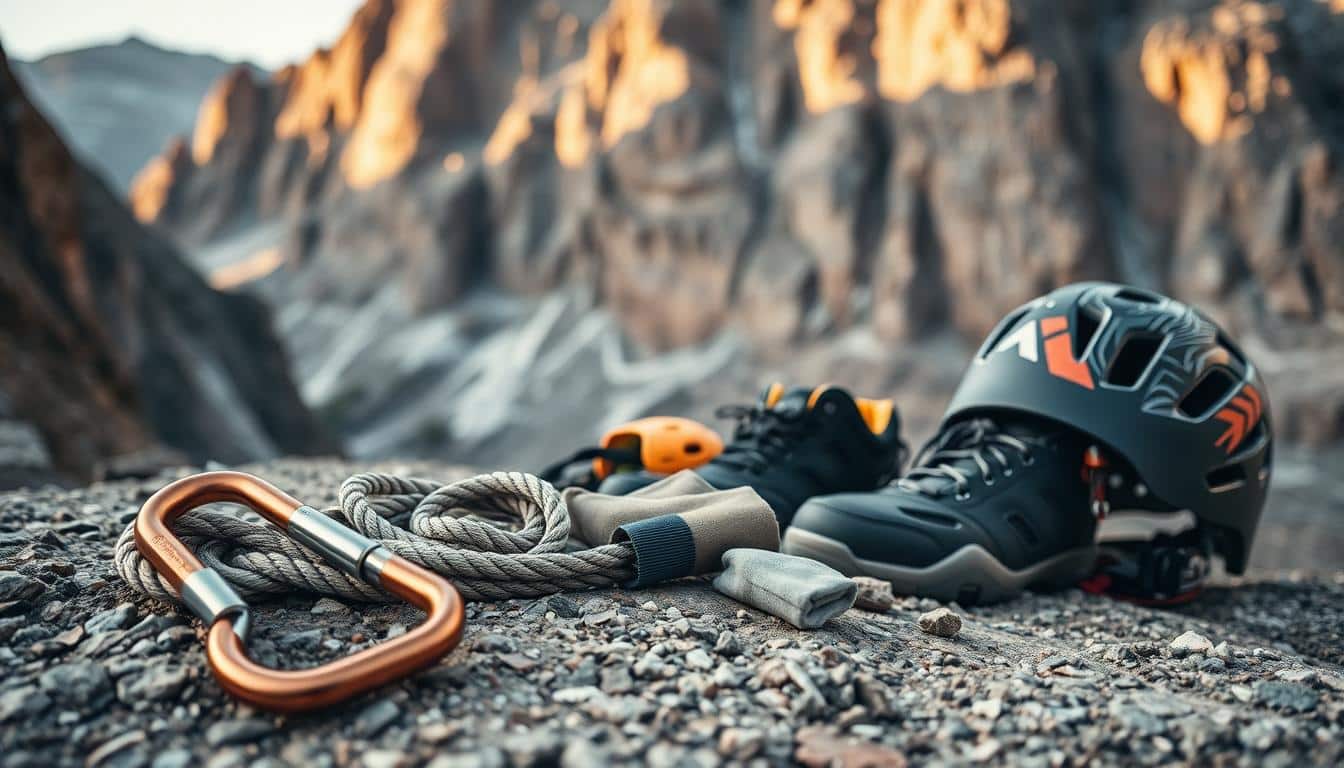Ever thought how the right gear can make a climb safe and exciting? In rock climbing, choosing the right gear is key to safety and performance. Knowing the must-have Safety Equipment is vital for all climbers. It keeps them safe and makes climbing better.
This article covers the basic gear every climber needs. It shows how the right equipment can improve your climbing.
Key Takeaways
- Proper gear enhances both safety and performance in rock climbing.
- Understanding different types of climbing gear is essential for effective climbing.
- Investing in reliable safety equipment can prevent accidents.
- Every climber, regardless of experience, requires essential climbing gear.
- Analyzing the functionalities of equipment provides a competitive edge.
Understanding the Basics of Rock Climbing Gear
Rock climbing comes in many styles, each with its own challenges and settings. Knowing these styles helps climbers improve their skills and choose the right gear for safety and performance.
Types of Rock Climbing
Bouldering, sport climbing, and traditional climbing are the main types. Bouldering is about short, intense climbs without ropes, needing crash pads for safety. Sport climbing uses fixed anchors and ropes, along with harnesses and quickdraws for safety. Traditional climbing relies on removable gear for protection.
Each style has its own gear designed to meet its specific needs.
Importance of Proper Gear
Choosing the right gear is key for safety and better performance in Outdoor Adventures. The right gear, like ropes, harnesses, and shoes, is essential. Bad gear can make climbing unsafe and less effective. Always invest in quality gear for a safe and fun climb.
Harnesses: Safety Comes First
Choosing the right Climbing Harness is key for safety. It’s important to think about comfort, fit, and the type of climbing. There are sport harnesses for quick moves and trad harnesses for longer climbs.
Choosing the Right Harness
Consider your climbing style and how often you climb. Sport harnesses are light, while trad harnesses are comfy for long climbs. Make sure the harness fits well, allowing for movement and safety.
Features to Consider
Look for adjustable leg loops and gear loops for storing equipment. The harness’s weight is also important. Brands like Black Diamond and Petzl offer safe and reliable options. The right harness boosts performance and safety.
Climbing Shoes: Grip and Comfort
Choosing the right Rock Climbing Shoes is key to a great climbing experience. They support performance and safety, letting climbers face different terrains confidently. Climbing shoes come in three main types, each for a specific climbing style and comfort need.
Types of Climbing Shoes
Neutral shoes are perfect for beginners. They focus on comfort, making them great for long climbs. Moderate shoes strike a balance between performance and comfort, appealing to climbers who want flexibility.
For those who climb often, aggressive shoes offer top-notch grip and precision. They might be less comfortable, but they’re worth it for serious climbers. Brands like La Sportiva and Scarpa offer a wide range, so there’s something for everyone.
How to Fit Climbing Shoes
Finding the right fit in Climbing Shoes is essential for comfort. They should fit snugly but not hurt. The materials, like leather or synthetic, affect comfort and durability.
The rubber sole’s type also matters for grip, which is critical for holding onto footholds. Learning how to fit shoes properly is vital. It ensures you perform well and stay safe, reducing injury risks.
Belay Devices: Managing Safety in Groups
Belay devices are key to keeping climbers safe in groups. Knowing the different types and how they work is important. Each device has its own benefits for different climbing situations, making climbing safer for everyone.
Different Types of Belay Devices
There are three main types of belay devices: tubular, assisted-breaking, and figure 8. Tubular devices are simple and light, great for top-roping and sport climbing. Assisted-breaking devices help by adding extra braking power, which is good for beginners. Figure 8 devices are less common but great for rappelling, providing smooth control on long descents.
Best Practices for Using Belay Devices
Learning the best ways to use a belay device is vital to stay safe. Climbers should practice in safe places, with the help of an experienced instructor. This training helps them understand how to use the device and handle different situations.
Regular drills also make climbers better at handling various climbing scenarios. This practice reinforces safe climbing practices, making group climbs safer for everyone.

Climbing Ropes: Lifelines for Climbers
Climbing ropes are key to keeping climbers safe. It’s important to know the difference between static and dynamic ropes. Dynamic ropes are great for lead climbing because they absorb shock well. Static ropes are better for rappelling and hauling gear because they stretch less.
Static vs. Dynamic Ropes
Dynamic ropes stretch when loaded, which helps absorb fall impact. This makes them safer for climbers. Static ropes don’t stretch much, making them good for hanging or tension activities. When picking a rope, think about diameter, length, and use. Mammut and Sterling have many options for different climbing needs.
Rope Maintenance Tips
Keeping climbing ropes in good shape is key. Check ropes for frays or cuts often. Store them in a cool, dry place to keep them strong. Cleaning ropes as the maker suggests can also help.
Carabiners: Essential Connectors
Carabiners are key in rock climbing, linking harnesses, ropes, and gear. It’s important to know the types and how they work for safety.
Different Types of Carabiners
There are two main types: locking and non-locking carabiners. Locking ones prevent accidental opening and are safer. Non-locking ones are lighter and quicker to use, perfect for fast moves.
Each type has its own use. Climbers need to pick the right one for their needs.
Understanding Locking Mechanisms
Carabiners have different locks like screw, auto, and twist-lock. These locks keep the carabiner closed, making climbs safer. Knowing about these locks helps climbers stay safe and efficient.
Brands like Petzl and Black Diamond offer reliable carabiners. They’re a good choice for climbers wanting quality gear.

Chalk: Enhancing Grip and Performance
Chalk is key in rock climbing, helping to improve grip. It soaks up moisture from hands, making sure climbers have a firm hold. The right chalk can boost performance and confidence on climbs.
Types of Climbing Chalk
There are many types of climbing chalk, each for different needs. Loose chalk is versatile and easy to use during climbs. Chalk balls are cleaner, with less mess but great grip.
Liquid chalk bonds well and dries fast, perfect for long climbs. Brands like Friction Labs and Metolius offer top-notch chalk for all climbers.
When and How to Use Chalk
Using chalk right is important. Apply it before climbing and as needed. This keeps hands dry and secure.
For long climbs, check your grip often. Proper chalk use can make all the difference in a successful climb.
The Benefits of Joining LocalZ
Joining LocalZ makes climbing better for everyone. It connects climbers with local experts who offer specific services. This means finding the best climbs, instructors, and gear specialists is easier.
Users get help preparing for climbs and stay safe. It’s all about making each climb safe and fun.
How LocalZ Connects You to Local Experts
LocalZ is more than a directory. It helps climbers find local experts. This means getting advice and insights from experienced climbers.
It’s all about finding the right resources for your climb. This way, every climb is safe and enjoyable.
Supporting Community Through LocalZ
LocalZ supports the community by giving half of its fees to local groups. This helps the local economy and promotes climbing tourism. Climbers help grow the Climbing Community by joining LocalZ.

Personal Safety Gear: Helmets and More
In climbing, safety gear is key for safe and fun climbs. The climbing helmet is a must-have. It protects against head impacts and falling objects. When choosing a helmet, look at its weight, comfort, and how well it breathes.
A good helmet is light and comfortable. It lets climbers focus on their climb without worrying about safety.
There’s more to safety gear than helmets. Climbing tape protects hands, and crash pads are vital for bouldering. Choosing brands like Mammut means getting gear that’s safe and well-made.
For better climbing safety, check out this link. It has top safety gear for climbers.
Exploring Local Rock Climbing Resources
For climbers looking to improve, LocalZ is a big help. It’s a directory of climbing gyms, giving access to training and resources. Climbers can find places near them for lessons, workshops, and events.
Discover Local Climbing Gyms with LocalZ
LocalZ makes it easy to find gyms for all skill levels. These gyms have expert instructors and top-notch climbing walls. They focus on safety and teaching the right techniques.
Connecting with Local Climbing Communities
Joining local climbing groups makes climbing better. You can learn from others and share tips on routes and safety. Being part of a community keeps you informed and supported.

